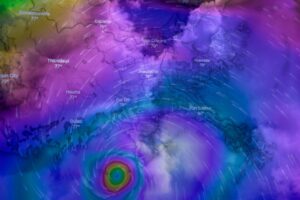Physical Address
23,24,25 & 26, 2nd Floor, Software Technology Park India, Opp: Garware Stadium,MIDC, Chikalthana, Aurangabad, Maharashtra – 431001 India
Physical Address
23,24,25 & 26, 2nd Floor, Software Technology Park India, Opp: Garware Stadium,MIDC, Chikalthana, Aurangabad, Maharashtra – 431001 India

Are storms actually getting stronger, or is it just media hype? Scientific research overwhelmingly supports the fact that climate change is intensifying storms, making them more powerful, wetter, and longer-lasting.
An X post has several claims stating that evidences of increase in hurricane is a junk science answer.
Claim post:
Claim 1: “Intensity of storms is decreasing per storm, as per graphs.”
Fact 1: Recent studies indicate that the intensity of hurricanes has increased over the past decades.
Empirical data suggest an increase in hurricane intensity in recent decades. The National Climate Assessment reports a substantial rise in the intensity, frequency, and duration of North Atlantic hurricanes since the early 1980s, particularly in Category 4 and 5 storms. Additionally, the U.S. Environmental Protection Agency’s Accumulated Cyclone Energy (ACE) Index, which measures the combined strength and duration of tropical storms and hurricanes, shows a noticeable increase over the past 30 years, with eight of the ten most active years since 1950 occurring post-mid-1990s. Therefore, the claim that storm intensity is decreasing contradicts current scientific observations.
Claim 2: “Destruction is a habitat factor—not a weather factor.”
Fact 2: Hurricanes’ destructiveness is influenced by their physical characteristics (e.g., wind speed, rainfall, storm surge) and the vulnerability of the affected area.
Hurricane damage results from a combination of meteorological factors and the characteristics of the impacted region. The National Hurricane Center identifies wind speed, storm surge, and rainfall-induced flooding as primary contributors to hurricane damage. Simultaneously, the extent of destruction is also determined by human factors such as population density, building codes, and preparedness levels.
For instance, the Center for Science Education notes that storm surge—the abnormal rise of water generated by a storm—is often the greatest threat to life and property, with its impact influenced by coastal topography and infrastructure resilience. Environmental and human factors play significant roles in determining hurricane destructiveness.
Claim 3: “Storms are not increasing.”
Fact 3: While the overall number of tropical cyclones globally has remained relatively stable, evidence suggests an increase in the frequency of the most intense storms.
The total number of tropical cyclones worldwide has not shown a significant upward trend. However, evidence indicates an increase in the frequency of the most intense hurricanes. The National Climate Assessment reports a substantial increase in the number of the strongest (Category 4 and 5) hurricanes since the early 1980s. Similarly, the U.S. Environmental Protection Agency’s ACE Index reflects a rise in cyclone intensity over the past 30 years. Therefore, while the overall storm count remains stable, the occurrence of more severe storms has increased.
References:
https://science.nasa.gov/climate-change/extreme-weather
https://nca2014.globalchange.gov/report/our-changing-climate/changes-hurricanes
https://nca2014.globalchange.gov/report/our-changing-climate/changes-hurricanes
https://scied.ucar.edu/learning-zone/storms/what-causes-storm-surge
https://www.sciencedirect.com/science/article/pii/S2225603223000437
Banner image:
Photo by Brian McGowan on Unsplash